Asia-Pacific Lithium-ion Battery for Electric Vehicle Market Size
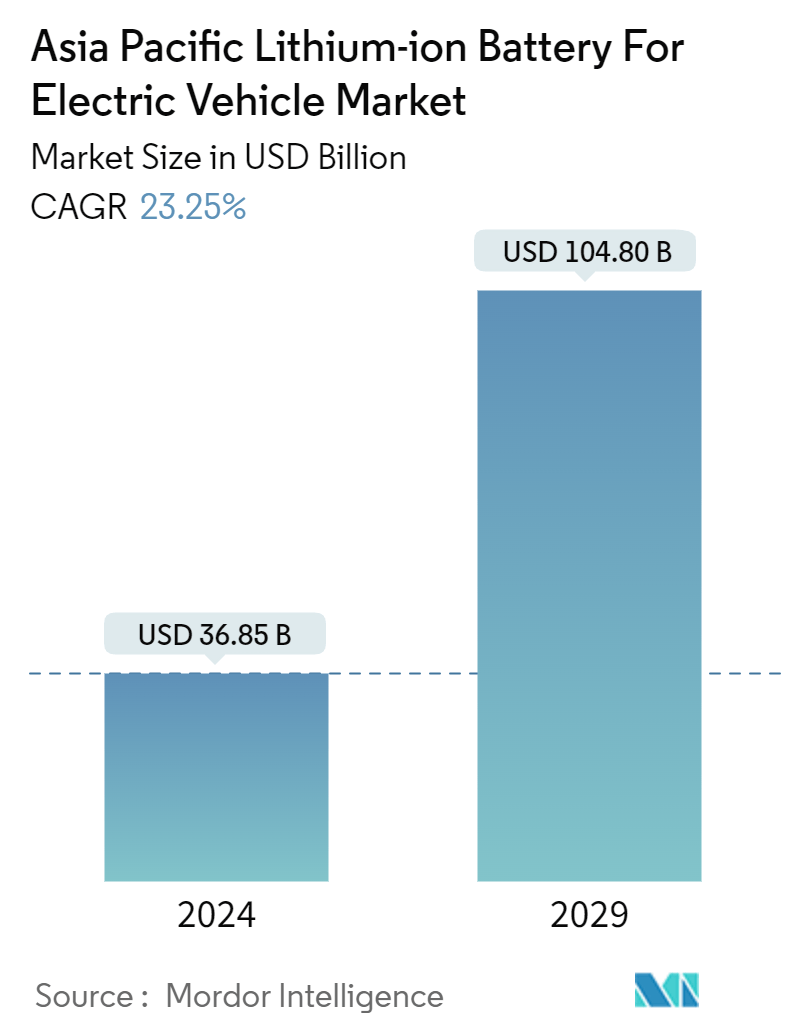
| Study Period | 2019 - 2029 |
| Base Year For Estimation | 2023 |
| Market Size (2024) | USD 36.85 Billion |
| Market Size (2029) | USD 104.80 Billion |
| CAGR (2024 - 2029) | 23.25 % |
| Market Concentration | Medium |
Major Players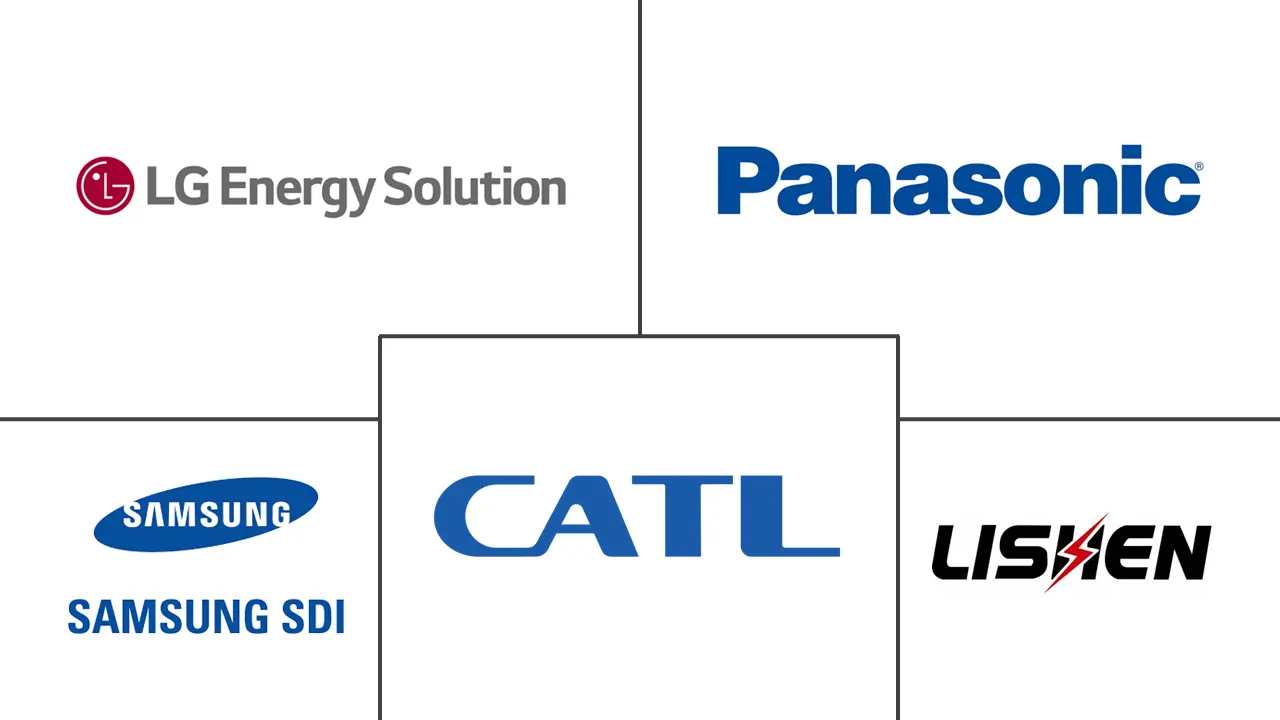
*Disclaimer: Major Players sorted in no particular order |
Asia-Pacific Lithium-ion Battery for Electric Vehicle Market Analysis
The Asia Pacific Lithium-ion Battery For Electric Vehicle Market size is estimated at USD 36.85 billion in 2024, and is expected to reach USD 104.80 billion by 2029, growing at a CAGR of 23.25% during the forecast period (2024-2029).
- Declining lithium-ion battery prices, the increasing adoption of electric vehicles, and supportive government policies and initiatives are expected to drive the growth of the Asia-Pacific lithium-ion battery for electric vehicle market over the medium term of the forecast period.
- On the other hand, emerging alternative battery technologies are likely to hinder market growth during the forecast period.
- Nevertheless, the need for lithium-ion batteries for hybrid electric vehicle (HEV) applications in emerging economies is expected to create vast opportunities for lithium-ion batteries for the electric vehicle market in Asia-Pacific.
Asia-Pacific Lithium-ion Battery for Electric Vehicle Market Trends
The Battery Electric Vehicle (BEV) Segment to Witness Significant Growth
- Battery electric vehicles (BEVs) are also commonly referred to as electric vehicles with an electric motor. BEVs are fully electric vehicles that typically do not include an internal combustion engine (ICE), fuel tank, or exhaust pipe and rely on electricity for propulsion. The vehicle's energy comes from a battery pack, which is recharged from the grid. BEVs are zero-emission vehicles, as they do not generate harmful tailpipe emissions or air pollution hazards caused by traditional gasoline-powered vehicles.
- The automotive industry in Asia-Pacific has been transforming over the years, with electric vehicles, particularly battery electric vehicles (BEVs), gaining momentum and popularity. With growing technological advancements, government support, and increasing environmental concerns, BEVs have emerged as a promising solution to address the challenges of climate change and reduce reliance on fossil fuels.
- In recent years, the adoption of battery-electric vehicles has grown significantly worldwide. The improvement of battery technology has led to extended driving ranges and a surge in charging infrastructure that is helping overcome the initial entry barriers. Further, automakers such as Tesla, BYD, Tata, Toyota, and Honda have been playing a vital role in popularizing BEVs, offering affordable models that appeal to a broader range of consumers.
- According to the International Energy Agency (IEA), the battery electric vehicle (BEV) car stocks in China stood at around 16 million units in 2023. Similarly, in the same year, countries such as India, Japan, and South Korea had approximately 0.15 million, 0.29 million, and 0.46 million units of BEV car stock, respectively. Similarly, in 2023, BEV sales in China stood at over 5.4 million. India sold around 82,000 units of BEV cars, while Japan and South Korea sold 88,000 and 120,000 units of BEV cars, respectively. As the sales of BEVs continue to rise, the demand for EV batteries, such as lithium-ion batteries, has become increasingly vital.
- Moreover, being one of the largest markets for BEV vehicles, Asia-Pacific is also the largest EV battery manufacturing region in the world. China led from the front with an EV battery demand of about 417 GWh per year, or about 54% of the world demand in 2023, recording a surge of over 32% from 2022. This highlights the importance of the region's dominance in EV battery technologies. Similarly, as per the International Energy Agency (IEA), the lithium-ion battery manufacturing capacity in the Asia-Pacific region is expected to grow significantly in the coming years, with China leading the way. The agency estimated that the Chinese lithium-ion battery manufacturing capacity will rise to 4.65 TWh in 2030 from around 1.20 TWh in 2022.
- To accelerate the adoption of BEVs, countries have been implementing various initiatives and incentives. For example, to reduce dependency on imported advanced chemistry cell (ACC) batteries for electric vehicles, the Indian government approved a Production Linked Incentive (PLI) Scheme in early 2021 for the manufacturing of ACCs in the country. The total outlay of the Scheme is USD 2.12 billion for five years. The scheme envisages establishing a competitive ACC battery manufacturing setup in the country (50 GWh). In addition, 5 GWh of niche ACC technologies is also covered under the scheme. Such initiatives are supporting the demand for lithium-ion batteries for EV applications.
- Further, Southeast Asian countries such as Thailand, Indonesia, Singapore, Malaysia, and the Philippines are expected to see rapid growth in the adoption of lithium-ion batteries due to the increasing prevalence of EVs and government initiatives to accelerate EV use. For example, Indonesia has an ambitious target of having EVs make up 20% of all car sales by 2025, and the Indonesian government aims for 600,000 EVs to be domestically produced by 2030. Such targets are translated into different milestones within the EV supply chain, including the lithium-ion batteries market.
- In early 2024, the EV Board in Thailand approved the second phase of the EV Package, known as EV 3.5, for four years (2024-2027) to promote the EV industry's continuous progress and facilitate investment opportunities in EV manufacturing in Thailand for new players. The package aims to boost investments covering the entire EV industry ecosystem. As part of the package, the Thai government will offer subsidies for the purchase of electric cars, electric pickup trucks, and electric motorcycles based on the vehicle types and battery capacities. Thailand's continuous EV promotion package since 2017 has resulted in investments in the EV industry worth USD 1.8 billion in manufacturing BEVs, battery electric motorcycles, EV parts and components, and charging stations.
- Therefore, due to the factors mentioned above, the BEV segment is likely to dominate the lithium-ion battery for electric vehicle (EV) market during the forecast period.
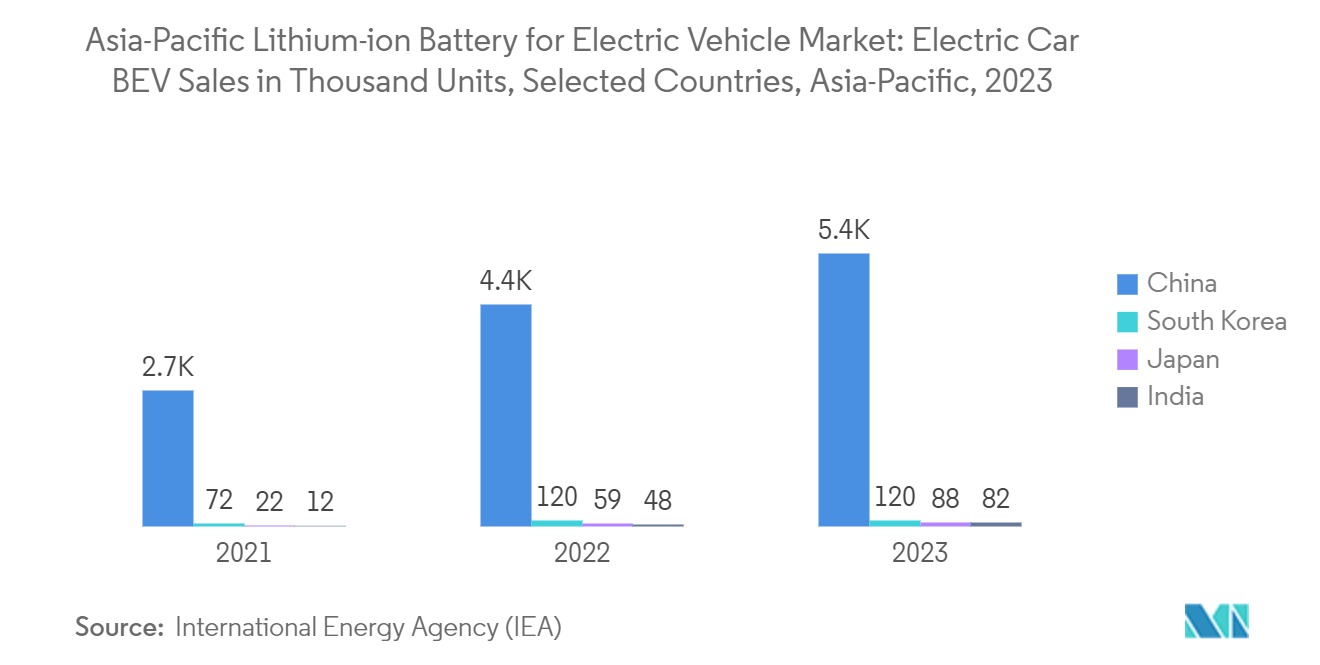
India to Witness Fastest Growth
- India is emerging as one of the fastest-growing markets for lithium-ion batteries, driven by a strong push toward the adoption of electric vehicles (EVs). For example, according to the International Energy Agency (IEA), battery electric vehicle (BEV) sales in India reached around 82,000 units in 2023, an increase of over 70% from 2022. Additionally, the Indian government aims for an EV target of 30% of newly registered private cars, 40% of buses, 70% of commercial cars, and 80% of 2-wheelers and 3-wheelers by 2030. These are likely to create a substantial demand for EV batteries, such as lithium-ion batteries, in the coming years.
- Besides, the government has also implemented a range of policies and incentives to encourage the shift from traditional internal combustion engine vehicles to EVs, significantly boosting the demand for lithium-ion batteries. With initiatives such as the Faster Adoption and Manufacturing of Hybrid and Electric Vehicles (FAME) scheme, India is making substantial investments in charging infrastructure, battery manufacturing, and subsidies for EV buyers, creating a conducive environment for market growth.
- More recently, in March 2024, the Indian government approved a new USD 500-million-worth EV Policy, offering a range of incentives to draw investments from global EV companies and position India as a prime manufacturing hub for state-of-the-art EVs. Other objectives include providing Indian consumers with access to cutting-edge EV models, expanding the Make in India ecosystem, lowering costs of production, and fostering a competitive domestic auto manufacturing industry.
- Various local and international players are investing in the Indian lithium-ion battery market, aiming to capitalize on the country's burgeoning energy storage needs and its transition toward sustainable solutions. For example, in April 2022, battery behemoth Exide Industries announced plans to invest about USD 718 million to set up a lithium-ion cell manufacturing plant in Karnataka. In its first phase, a 6 GWh lithium-ion cell manufacturing facility is likely to become operational by 2024, gradually expanding to a 12 GWh capacity integrated lithium-ion battery facility over the next few years.
- Furthermore, in April 2023, the battery technology startup Log9 Materials inaugurated the country's first lithium-ion cell manufacturing facility in Jakkur, Bengaluru. The plant has an initial capacity of 50 MWh. The company is also working on expanding its lithium-ion cell manufacturing capacity to 1 GWh and its battery pack manufacturing capacity to 2 GWh by the first quarter of 2025.
- Overall, with a large consumer base, supportive policies, and increasing progress in the batteries manufacturing, the lithium-ion battery for electric vehicle (EV) market in India is poised for further growth in the coming years.
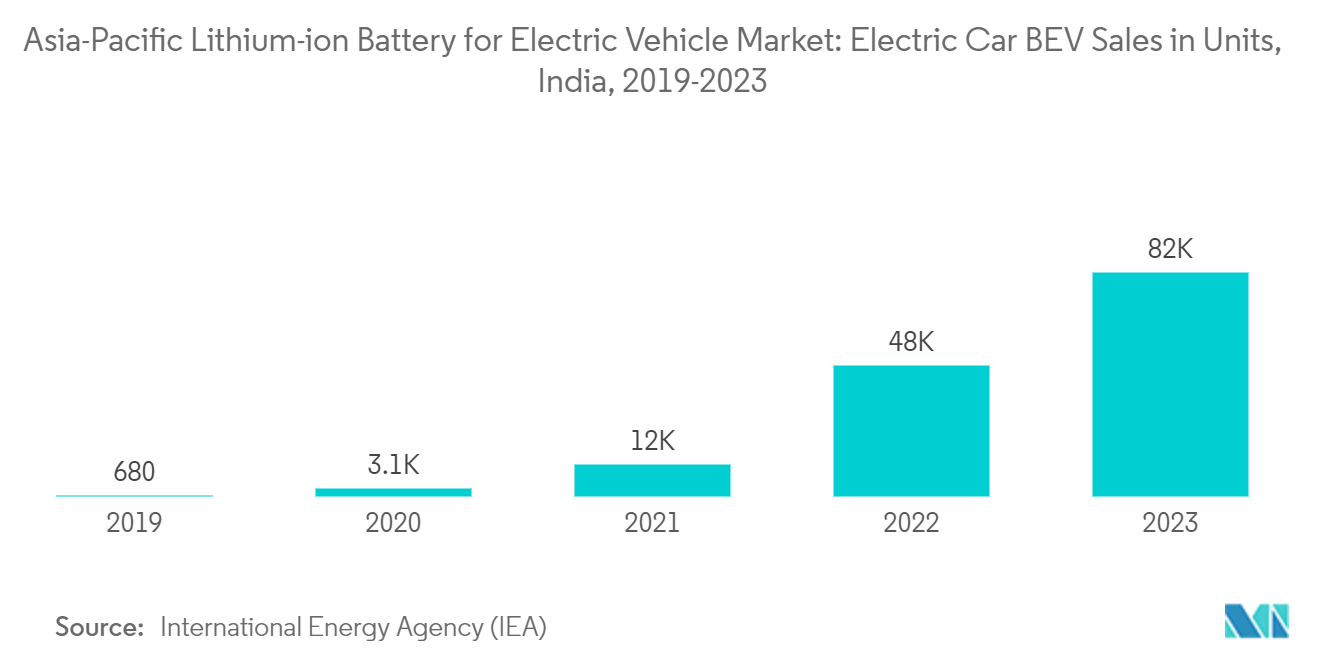
Asia-Pacific Lithium-ion Battery for Electric Vehicle Industry Overview
The Asia-Pacific lithium-ion battery market for electric vehicles is semi-fragmented. Some of the key players in the market (not in any particular order) include Panasonic Corporation, Contemporary Amperex Technology Co. Limited, Tianjin Lishen Battery Joint-Stock Co. Ltd, Samsung SDI Co. Ltd, and LG Energy Solution Ltd.
Asia-Pacific Lithium-ion Battery for Electric Vehicle Market Leaders
-
Panasonic Corporation
-
Samsung SDI Co., Ltd.
-
Contemporary Amperex Technology Co. Ltd (CATL)
-
Tianjin Lishen Battery Joint-Stock Co., Ltd.
-
LG Energy Solution Ltd.
*Disclaimer: Major Players sorted in no particular order
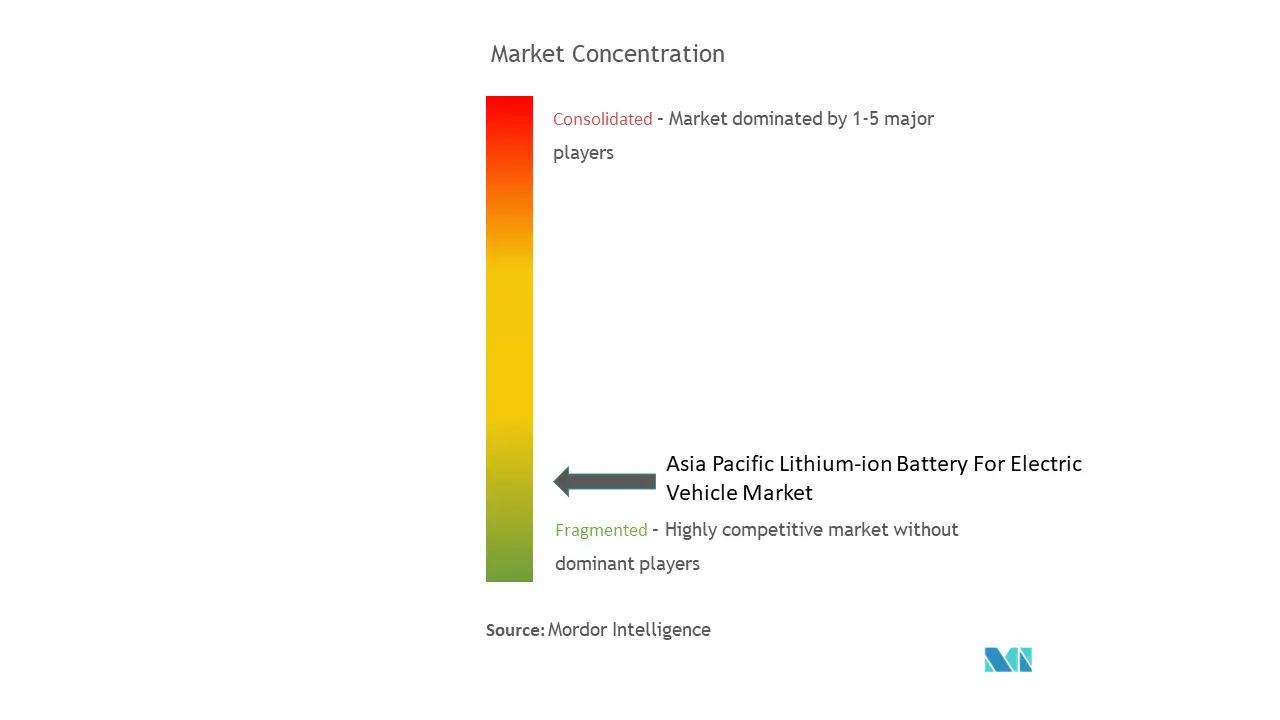
Asia-Pacific Lithium-ion Battery for Electric Vehicle Market News
- March 2024: Panasonic Group announced that it would form a joint venture with Indian Oil Corporation Ltd (IOCL) to manufacture cylindrical lithium-ion batteries. Panasonic Energy, a group firm, signed a binding term sheet and initiated discussions with IOCL to draw a framework for the formation of a joint venture to manufacture cylindrical lithium-ion batteries. This initiative is driven by the expected expansion of demand for batteries for two and three-wheelers and BESSs in the Indian market.
- January 2024: International Battery Company (IBC), which makes rechargeable lithium-ion batteries, secured USD 35 million as a part of its Pre-Series A funding round led by RTP Global, with participation from Beenext, Veda VC, and a few other strategic Korean and US investors. The company offers rechargeable batteries to its customers operating in small mobility sectors in India. The funding supports IBC’s manufacturing expansion and the establishment of advanced data systems. The company will advance the progression of a "copy exact," new 2 GWh lithium-ion Giga factory in Bengaluru, which will commence production by 2025. In August 2023, the US-based IBC inked an MoU with the Karnataka government to establish the lithium-ion manufacturing unit, investing USD 958 million in a 100-acre facility in the Bengaluru rural district. The plant is set to commence production by 2025, with IBC targeting a capacity of 10 gigawatts by 2028.
Asia-Pacific Lithium-ion Battery for Electric Vehicle Market Report - Table of Contents
1. INTRODUCTION
- 1.1 Scope of the Study
- 1.2 Market Definition
- 1.3 Study Assumptions
2. EXECUTIVE SUMMARY
3. RESEARCH METHODOLOGY
4. MARKET OVERVIEW
- 4.1 Introduction
- 4.2 Market Size and Demand Forecast in USD until 2029
- 4.3 Recent Trends and Developments
- 4.4 Government Policies and Regulations
-
4.5 Market Dynamics
- 4.5.1 Drivers
- 4.5.1.1 Declining Lithium-ion Battery Prices
- 4.5.1.2 Increasing Adoption of Electric Vehicles
- 4.5.1.3 Supportive Government Policies and Initiatives
- 4.5.2 Restraints
- 4.5.2.1 Emerging Alternative Battery Technologies
- 4.6 Supply Chain Analysis
-
4.7 Industry Attractiveness - Porter's Five Forces Analysis
- 4.7.1 Bargaining Power of Suppliers
- 4.7.2 Bargaining Power of Consumers
- 4.7.3 Threat of New Entrants
- 4.7.4 Threat of Substitute Products and Services
- 4.7.5 Intensity of Competitive Rivalry
5. MARKET SEGMENTATION
-
5.1 By Vehicle Type
- 5.1.1 Passenger Vehicles
- 5.1.2 Commercial Vehicles
- 5.1.3 Other Vehicle Types (Bikes, Scooters, etc.)
-
5.2 By Propulsion Type
- 5.2.1 Battery Electric Vehicle (BEV)
- 5.2.2 Plug-in Hybrid Electric Vehicle (PHEV)
- 5.2.3 Hybrid Electric Vehicle (HEV)
-
5.3 By Geography
- 5.3.1 India
- 5.3.2 China
- 5.3.3 Japan
- 5.3.4 South Korea
- 5.3.5 Thailand
- 5.3.6 Indonesia
- 5.3.7 Vietnam
- 5.3.8 Rest of Asia-Pacific
6. COMPETITIVE LANDSCAPE
- 6.1 Mergers and Acquisitions, Joint Ventures, Collaborations, and Agreements
- 6.2 Strategies Adopted & SWOT Analysis for Leading Players
-
6.3 Company Profiles
- 6.3.1 Panasonic Corporation
- 6.3.2 Samsung SDI Co. Ltd
- 6.3.3 Contemporary Amperex Technology Co. Ltd (CATL)
- 6.3.4 BYD Company Limited
- 6.3.5 Tianjin Lishen Battery Joint-Stock Co. Ltd
- 6.3.6 Trontek Electronics Pvt. Ltd
- 6.3.7 Greenfuel Energy Solutions Pvt. Ltd
- 6.3.8 LG Energy Solution Ltd
- 6.3.9 SK Innovation Co Ltd
- 6.3.10 AESC Group Ltd
- 6.3.11 Tesla Inc.
- *List Not Exhaustive
- 6.4 List of Other Prominent Companies (Company Name, Headquarter, Relevant Products & Services, Contact Details, etc.)
- 6.5 Market Ranking Analysis
7. MARKET OPPORTUNITIES AND FUTURE TRENDS
- 7.1 Adoption of Solid-state Lithium-ion Batteries for Electric Vehicles
Asia-Pacific Lithium-ion Battery for Electric Vehicle Industry Segmentation
- A lithium-ion battery for electric vehicles (EVs) is a type of rechargeable battery commonly used to power electric cars and other electric transportation. Known for its high energy density, long cycle life, and lightweight design, this battery technology enables efficient storage and delivery of electrical energy. Lithium-ion batteries consist of cells containing an anode, cathode, separator, and electrolyte. These batteries offer a high power-to-weight ratio, excellent energy efficiency, and reduced self-discharge compared to other rechargeable batteries, making them a preferred choice for modern electric vehicles.
- The Asia-Pacific lithium-ion battery for electric vehicle market is segmented into vehicle type, propulsion type, and geography. By vehicle type, the market is segmented into passenger vehicles, commercial vehicles, and other vehicle types (bikes, scooters, etc.). By propulsion type, the market is segmented into battery electric vehicles (BEV), hybrid electric vehicles (HEV), and plug-in hybrid electric vehicles (PHEV). The report also covers the market size and forecasts for the lithium-ion battery for the electric vehicle market across major countries. The report offers the market size and forecasts for the market in revenue in USD for all the segments mentioned above.
| By Vehicle Type | Passenger Vehicles |
| Commercial Vehicles | |
| Other Vehicle Types (Bikes, Scooters, etc.) | |
| By Propulsion Type | Battery Electric Vehicle (BEV) |
| Plug-in Hybrid Electric Vehicle (PHEV) | |
| Hybrid Electric Vehicle (HEV) | |
| By Geography | India |
| China | |
| Japan | |
| South Korea | |
| Thailand | |
| Indonesia | |
| Vietnam | |
| Rest of Asia-Pacific |
Asia-Pacific Lithium-ion Battery for Electric Vehicle Market Research FAQs
How big is the Asia-Pacific Lithium-ion Battery For Electric Vehicle Market?
The Asia-Pacific Lithium-ion Battery For Electric Vehicle Market size is expected to reach USD 36.85 billion in 2024 and grow at a CAGR of 23.25% to reach USD 104.80 billion by 2029.
What is the current Asia-Pacific Lithium-ion Battery For Electric Vehicle Market size?
In 2024, the Asia-Pacific Lithium-ion Battery For Electric Vehicle Market size is expected to reach USD 36.85 billion.
Who are the key players in Asia-Pacific Lithium-ion Battery For Electric Vehicle Market?
Panasonic Corporation, Samsung SDI Co., Ltd., Contemporary Amperex Technology Co. Ltd (CATL), Tianjin Lishen Battery Joint-Stock Co., Ltd. and LG Energy Solution Ltd. are the major companies operating in the Asia-Pacific Lithium-ion Battery For Electric Vehicle Market.
What years does this Asia-Pacific Lithium-ion Battery For Electric Vehicle Market cover, and what was the market size in 2023?
In 2023, the Asia-Pacific Lithium-ion Battery For Electric Vehicle Market size was estimated at USD 28.28 billion. The report covers the Asia-Pacific Lithium-ion Battery For Electric Vehicle Market historical market size for years: 2019, 2020, 2021, 2022 and 2023. The report also forecasts the Asia-Pacific Lithium-ion Battery For Electric Vehicle Market size for years: 2024, 2025, 2026, 2027, 2028 and 2029.
Asia-Pacific Lithium-ion Battery for Electric Vehicle Industry Report
Statistics for the 2024 Asia-Pacific Lithium-ion Battery For Electric Vehicle market share, size and revenue growth rate, created by Mordor Intelligence™ Industry Reports. Asia-Pacific Lithium-ion Battery For Electric Vehicle analysis includes a market forecast outlook for 2024 to 2029 and historical overview. Get a sample of this industry analysis as a free report PDF download.



